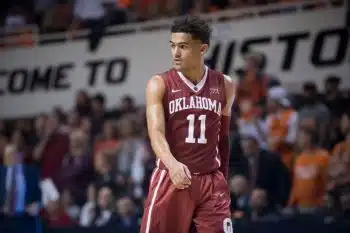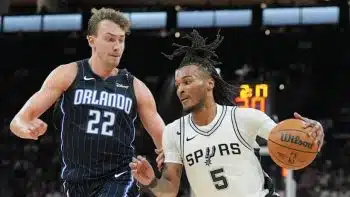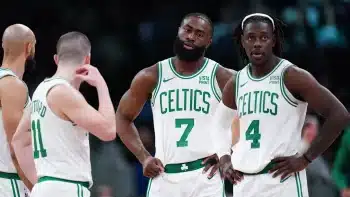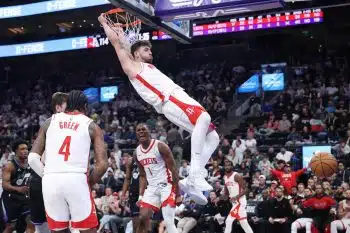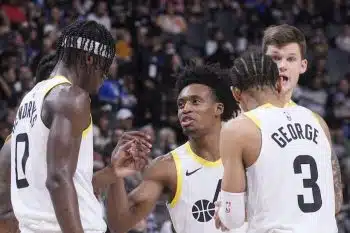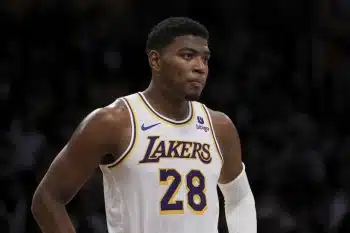NBA
Now What? New York Knicks
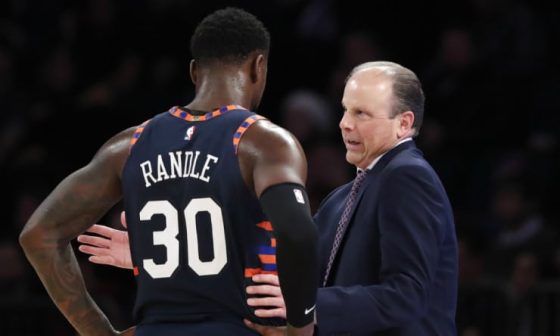
Basketball Insiders’ “Now What” series examines teams on the precipice of success. Some will succeed in their attempt to join the elite, while others will squander an opportunity or are simply out of time. Today, we’ll dissect the New York Knicks, their 2020-21 season and where they go from here.
The New York Knicks had a miraculous season relative to preseason expectations. They secured the fourth seed in the Eastern Conference after winning 56.9 percent of their regular season games, ended the season with the league’s third-best defensive rating and proudly sent a representative to the All-Star game for the first time since 2017-18. The Knicks also possess the league’s 13th youngest roster with four of their key players younger than 22 years old (RJ Barrett, Immanuel Quickley, Obi Toppin and Mitchell Robinson).
Ultimately, the future looks bring in New York. But while this season was a nice change-of-pace story for a franchise that’s had little (to no) positive news mentions of late, there’s plenty of work to do to go from the first round of the playoffs to perennial title contender. So, now what for the Knicks?
Strengths
Coaching staff and defense: The Knicks exited the 2019-20 season among the worst defensive teams in the NBA – but that didn’t last long. Much of their defensive improvements can be attributed to first-year head coach Tom Thibodeau. Thibodeau inherited a hodgepodge of defenders, but his strategies and philosophy got maximum production from the group. As mentioned above, the Knicks were the third-best defensive team in the league according to defensive rating, with the Knicks giving up 108.2 points per 100 possessions. That’s a significant improvement from 2019-20, when they were the 23rd best defense (113.0).
And while they are unlikely to receive any All-Defense nods, Nerlens Noel and Taj Gibson proved to be incredibly valuable signings in replacing Robinson after he suffered a fractured hand and a fractured foot.
But it wasn’t just production from the center position. The team’s coaching staff got maximum production out of Julius Randle and Barrett, both of whom were previously seen as defensive liabilities.
And just in case there was any doubt in Thibodeau’s impact, he was named Coach of the Year last week.
Shooting and efficiency: While improvements were evident on defense, no one worries about a Thibodeau team on the defensive end of the floor. The offense appeared to be a problem early on, though, and it was partially due to the team’s subpar three-point shooting. The Knicks shot just 35 percent on their three-point attempts through December and January.
But the Knicks had a surprise in store for everyone, shooting 40.6 percent from downtown in 51 games between February and May. A lot of that progress had to do with Randle and Barrett, both of whom struggled mightily with the long ball last season. Randle, whose shooting came apart in this post-season, shot a career-best 41 percent on three-point attempts over the entire season. And Barrett shot an incredible 40 percent from downtown, hitting on 48.2 percent on his three-point attempts in April and 45.5 percent in May.
Bullock, Burks, Rose and Quickley all shot the ball incredibly well, too.
Randle and Barrett: Ultimately, though, Randle is the team’s biggest strength entering the offseason. In addition to powering the team from a scoring standpoint, he also operated as its primary facilitator, averaging a career-best 6 assists per game and tallying 6 triple-doubles through the year. He secured his first All-Star selection, establishing himself as an unquestionable star and (possibly) putting New York back on the map as a free agent destination.
Barrett isn’t far behind Randle in terms of aspects of the team about which we should be enthusiastic. After a disappointing rookie season, Randle clearly made changes. He improved his overall shooting (40.2 percent to 44.1 percent) and three-point shooting (32 percent to 40.2 percent). He also boosted his overall scoring (14.3 to 17.6 points per game), while cutting his turnovers (2.2 to 1.9) and increasing his assists (2.6 assists per game to 3.0) and rebounding (5.0 rebounds per game to 5.8).
Barrett still has to improve his finishing around the rim, as well as his jump shot off-the-bounce. But Barrett just turned 22 and is entering only his second off-season as a pro. He showed more than enough to make the Knicks comfortable in his future.
Weaknesses
Guard play: The Knicks entered this season with holes in their guard rotation – and at the heart of it is Elfrid Payton. Payton was a major offensive liability, and that’s supported by virtually every metric imaginable. He ended the year with a -9.4 on/off per 100 possessions, he posted a measly 11.7 PER and he finished with a -.5 VORP (volume over replacement player).
The arrival of the 32-year-old Rose buoyed their backcourt a bit, but it wasn’t enough.
Still, coach Thibodeau stuck with Payton as their starter through the entirety of the regular season, finally caving and inserting Rose in game three of the first-round matchup against the Atlanta Hawks.
The Knicks must finally address the elephant in the room and bring in a starting-caliber point guard – and had they known they’d be competitive this season, they probably would have done so last year.
Shooting volume: Despite the improvements in shooting listed above, shooting issues remain. And just one juxtaposition is needed to demonstrate it: New York shot the third-best three-point percentage in the league while attempting the fourth-least three-pointers for the season. That’s a problem.
But some of the problem is roster construction, and a lot of that has to do with, again, the team outperforming expectations. The bottom line is the Knicks probably didn’t think they would need more shooters.
Bullock, Randle, Burks, Quickley and Barrett were their only players to average more than 4.0 three-point attempts per game. All five never share the floor (obviously), and the team’s most seven most commonly utilized lineups, accounting for 43 percent of the team’s total minutes this season, feature three of them or fewer.
As the team looks to re-sign (and replace) players this offseason, they’ll probably look to add a point guard and another wing, both of whom will hopefully be upgrades or additions from a shooting standpoint.
Opportunities
Draft picks: The Knicks are in a position of power from a draft standpoint. They own four draft picks in the 2021 NBA Draft, three of which are meaningful – 19, 21 (Dallas’ first-rounder) and Detroit’s 2nd rounder.
What the Knicks ultimately decide to do with their picks is anyone’s guess – and they’ll probably keep their cards close to the vest – but one thing’s for sure, they do not need to add three or four more young players to their rotation.
Assuming they can find a trade partner, packaging some combination of 19, 21 and Detroit’s 2nd should net them at least a late-lottery pick, like the Warriors second-lottery pick (14th overall), if not higher.
Ultimately, there are still lots of holes on the Knicks roster exiting this season, and there could be even more if they renounce a number of their own free agents in pursuit of an upgrade. On the bright side, roster holes means they won’t have to draft for position.
Free agency:
Depending on what the Knicks do with their free agents, they could free up as much as $70 million in cap space. Only four Knicks have fully guaranteed contracts for next season — Barrett, Toppin, Quickley and Kevin Knox II. Randle has a partial guarantee on his $19.8 million salary, and there is a team option for Robinson ($1.8 million). Further, Luca Vildoza and Norvel Pelle have non-guaranteed contracts, and Frank Ntilikina is due a qualifying offer, enabling him to enter restricted free agency.
The rest of their roster will be unrestricted free agents. There will be varying degrees of interest in bringing back Derrick Rose, Alec Burks, Nerlens Noel and Reggie Bullock, but there is virtually no chance of a reunion with former Magic-lottery pick, Elfrid Payton.
Ultimately though, the Knicks have two major decisions to make – what to do with Randle and who they can add to help them get to the next level. The former is mostly out of their hands. The Knicks will offer him as much as they can (4 years/$106 million). He will decline in hopes of securing a 5 year/$201 million contract next offseason. And no one can really blame him for it.
The latter point, though, is crucial. Ultimately, the biggest need is at point guard. And there will be free agent point guards available including Chris Paul (player option), Kyle Lowry (unrestricted free agent) and Lonzo Ball (restricted free agent).
Paul is currently 36 years old and Lowry is 35 – so neither is a long-term solution. As far as Ball is concerned, he will have several serious suitors, including the Bulls and Pelicans, as well as the Knicks.
If none of the above work out, the Knicks can also set their sights on younger options like restricted free agents 26-year-old Devonte’ Graham or 25-year-old Kendrick Nunn.
One thing is for sure, though: the Knicks need to upgrade the point guard position – and one of the aforementioned five players could be the answer.
Threats
The Knicks are in control of their important pieces, but there is still one major threat looming…
Regression: After a wildly successful season, the Knicks were escorted out of the playoffs in a gentlemen’s sweep by the Atlanta Hawks. Now, credit the Hawks, who played insanely well. But the Knicks, and mostly Randle, came up very short.
Randle, after posting a career year across the board, short an ice-cold 29.7 percent from the field, while looking lost amidst the defensive schemes concocted by Hawks’ coach Nate McMillian. Could next season’s iteration of Randle look more like the guy who averaged just 18 points per game in his five playoff games? Or will he look more like the player we saw throughout the regular season?
Time will tell, but one thing’s for sure – Randle is a worker. He got in the lab and improved in a way that surprised virtually everyone even remotely connected to the league, this writer included. Expecting a similar jump would be crazy, but he will probably work tirelessly to diagnose and solve whatever malfunctioned. Additionally, with a hopefully improved Barrett and a new co-star to be named later, Randle could look even better without improving – and betting on no strides in Randle’s game would amount to a bad wager.
Burn out: Coach Thibodeau has been criticized for overplaying his stars for the entirety of his coaching career (and I assessed the idea of player burnout and how it might impact Randle earlier this season here). But beyond the physical toll taken by heavy minutes on star players is the idea Thibodeau’s intense presence results in an immediate pump, which is ultimately an overinflated result. Could his voice weaken in year two with the Knicks simply because it’s no longer fresh?
Let’s get to the bottom of this by examining Thibodeau’s past. Thibodeau’s first two seasons in Chicago ended with him winning 75.6 percent of all games. Then, he won just 55 percent, 58.5 percent and 61 percent of his games in his next three seasons, respectively.
In Minnesota, he won 37.8 percent in his first season. Then, the Timberwolves took a hyperbolic jump to a 57.3 winning percentage in year two, and then back down to 47.5 percent.
Does that provide any conclusive evidence in favor of the idea that Thibodeau loses his locker rooms? NO.
Thibodeau and the Knicks are a match made in heaven. Thibodeau will be fine. The Knicks will prosper under his guidance. Relax, New York. Nothing to see here.
Ultimately, the Knicks had an incredible season that was muddied by its ending, but it’s always tough to see the forest through the trees. Try to remember that the Knicks won 41 (of their 72) games this season. It took more than the previous two seasons combined to come up with that many wins. Are they championship contenders yet? No. But they skipped right past the mediocre step of the rebuilding process – and that is something.
